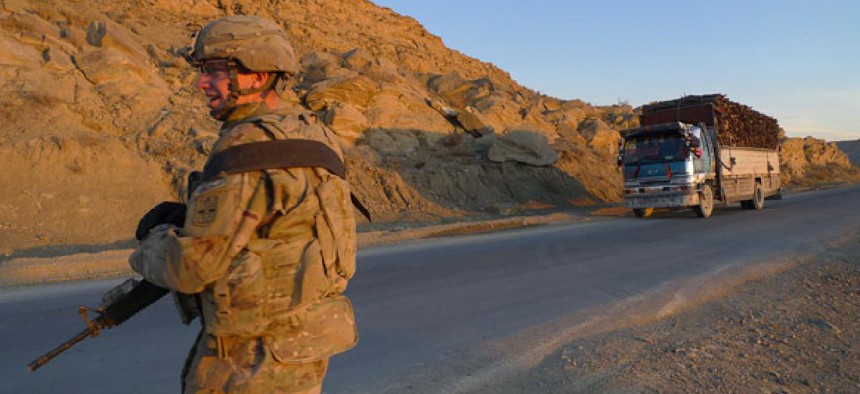
A U.S. soldier holds security duty in Paktika province. Heidi Vogt/AP
New Afghan attack raises doubts about U.S.-funded militias
Program is central to the plan for stabilizing Afghanistan, but incident suggests militia members aren't being properly vetted and overseen.
The killing of another American soldier by a purported Afghan ally doesn’t simply add to the grim tally of U.S. troops shot dead by their Afghan counterparts. It also raises questions about a key aspect of the American plan for gradually winding down the war.
The soldier, who hasn’t yet been identified, wasn’t killed by members of the Afghan army or police, the insurgent-riddled security forces responsible for the overwhelming majority of fratricidal attacks on NATO forces. Instead, he was killed by a member of the Afghan Local Police, a network of small militias funded – and in some cases armed - by the U.S. to fill the void left behind when American forces withdraw from remote parts of Afghanistan.
The program is central to the Obama administration’s plan for stabilizing Afghanistan as much as possible before withdrawing in 2014, but the attack suggests its members aren’t being properly vetted and overseen.
The program borrows a tactic from Iraq, and is meant to create local fighting forces capable of preventing the Taliban from returning to their former strongholds and keeping a measure of order in areas which are largely beyond the purview the fragile Afghan central government.
The number of fighters in the so-called “Afghan Local Police” initiative is set to more than triple over the next 18 months, rising from roughly 9,800 now to roughly 30,000 by the end of next year. Top American generals routinely describe it as a cornerstone of their broader strategy for the war.
Speaking to the Senate Armed Services Committee in March 2011, for instance, then-Afghan war commander Gen. David Petraeus called the ALP initiative “arguably the most critical element in our effort to help Afghanistan develop the capability to secure itself.”
The initiative was deeply controversial even before this latest attack. Last fall, a blistering assessment by Human Rights Watch found that ALP personnel were routinely breaking into houses, using checkpoints to demand bribes from motorists, improperly taxing local residents and arresting – and in some cases killing – local villagers.
“While some community defense force programs have been more successful than others, all have been plagued by failures of vetting and oversight, and, too often, impunity for human rights abuses,” the group concluded. “The ALP is a high-risk strategy to achieve short-term goals in which local groups are again being armed without adequate oversight or accountability.”
The program’s future will be further called into question if there are more incidents like Monday’s bloody shooting in eastern Afghanistan’s volatile Paktika Province. NATO officials say a member of an Afghan Local Police unit fired on American soldiers approaching a checkpoint, killing one American.
The Paktika attack came just hours after an Afghan soldier killed two British soldiers at a joint base in Lashkar Gah, a large city in southern Afghanistan. The three deaths brought the total number of NATO personnel killed this year in so-called “green on blue” attacks to 16. That makes them the second leading cause of coalition fatalities in 2012, trailing only the 22 troops killed by roadside bombs.
The shootings have been a cause of growing cause of anger throughout Washington and the other coalition capitols, where leading politicians are openly questioning why their troops don’t need to worry about the Taliban remotely as much as they’ve had to worry about the Afghan troops living, patrolling and walking beside them.
Earlier this year, France suspended its training operations inside Afghanistan after four of its soldiers were killed by one of their Afghan counterparts, though Paris later resumed the program.
Top American officials, meanwhile, insist their forces will continue to work alongside Afghan security personnel, but U.S. forces are taking steps which made clear just how big of a trust gap has developed between the two sides.
Speaking to reporters Monday, Gen. John Allen, the top U.S. commander in Afghanistan, said American troops assigned to small joint bases were changing their sleeping arrangements to ensure that American personnel were constantly monitoring their side of the compound and setting up other internal defenses to prevent Afghans from crossing over to kill U.S. personnel.
Actions speak louder than words, and those are the actions of a nation beginning to pull further away from a nominal ally.






